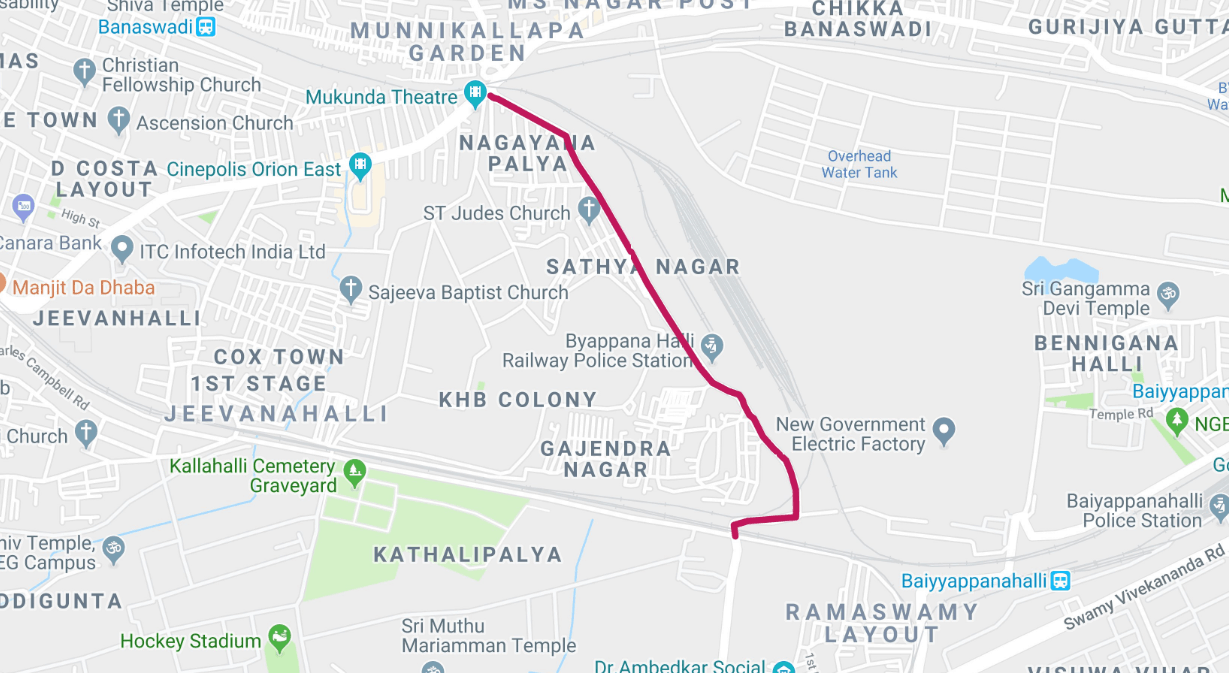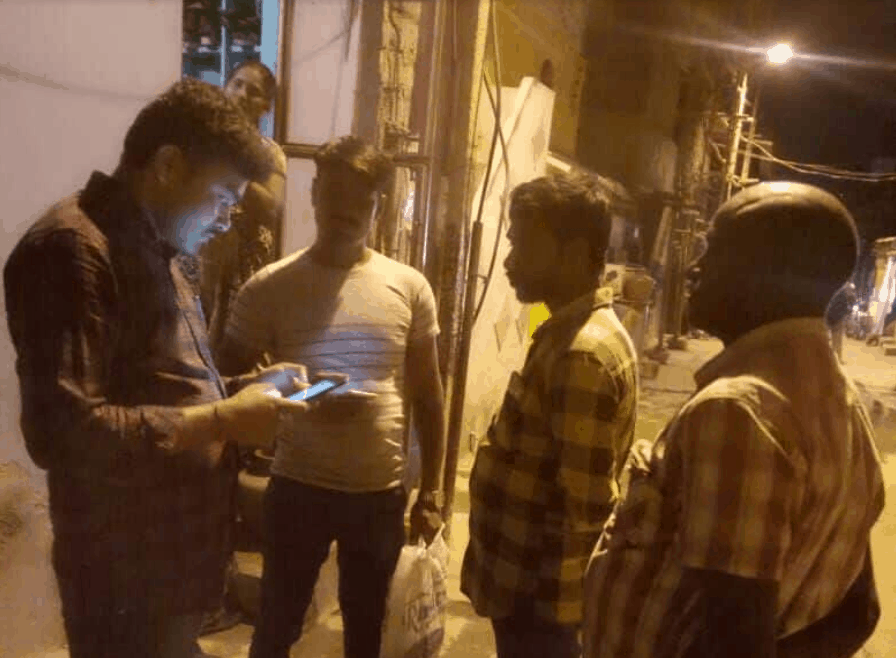“In your opinion, what is the most prevalent problem faced by the residents of your area?” three of us from the non-profit IT for Change, asked the youth of Old Baiyappanahalli a few months ago.
It didn’t take long for the youth to unanimously respond – the traffic at the railway gate, which had been the bane of their existence.
“It’s becoming impossible by the day!” they said in exasperation.
Further discussions revealed that Baiyappanahalli road was underserved by the Bangalore Metropolitan Transport Corporation (BMTC). This stretch connects Swami Vivekananda Road metro station (along Old Madras Road), to Maruti Seva Nagar. The lack of bus service has significantly affected the mobility of residents along the stretch, in Old Baiyappanahalli.

Marked in red is the stretch of Baiyappanahalli Road that’s not served by BMTC. The road connects Swami Vivekananda Road Metro station (towards the bottom) with Maruti Seva Nagar near Mukunda Theatre (towards top)
MBS 8 – the bus that used to ply along Baiyappanahalli Road – had discontinued its service here two years ago, due to heavy traffic at the railway gate before Old Baiyappanahalli. Buses now take a deviation ahead of the railway gate, bypassing the area. This leaves residents with no option but to go on foot from the railway gate to their houses – a distance of more than a kilometre. Else they have to hire share autos which is tiring, and heavy on the pocket.
Old Baiyappanahalli in East Bengaluru is largely a settlement of the urban poor, most of whom are illiterate and work in the informal sector. This community came about when migrant populations from five locations were resettled here in an ad hoc manner, in 1985. The majority of residents here are linguistic minorities from outside Karnataka. Despite the lack of facilities here, the community has rarely made formal representations to authorities.
Data campaign to make a strong case
The youth knew that a bus route was needed in the area, but merely requesting transport authorities for this service wouldn’t be enough. It would have to be backed by sufficient data and evidence, to prove that the entire community needed the bus facility. Hence they conducted a data campaign this March, on the lack of access to public transport here.
The campaign was part of the youth’s association with Spoorthi, a project initiated in March 2018. Spoorthi is a collaborative effort of three Bengaluru-based organisations – the Association for Voluntary Action and Services (AVAS), IT for Change, and the Centre for Study of Science, Technology and Policy (CSTEP).
The project works with 24 young ‘information and data stewards’ – young women and men from the communities of Old Baiyappanahalli, MRS Palya, Sanyasikunte and Chikballapur. It aims to build a community-based spatial data platform to monitor development goals, particularly in the areas of water, sanitation and health. The project attempts to create a bottom-up data system that can eventually be used for informed local-level decision-making and grievance redressal.
The stewards are also trained in basic digital literacy skills, information seeking, online civic engagement, and the use of GIS and GPS technologies. They learn about basic email and software applications, using internet to access information, and the use of Open Street Maps.
While some of the stewards are school and college students, others work at AVAS or in corporates. The digital literacy trainings have enhanced their skill-sets and also their comfort in using technology. Stewards are also exposed to urban governance mechanisms such as the 74th amendment of the Indian Constitution, and online grievance redressal portals in the city.
The stewards’ data campaign on transport was part of this learning process. They surveyed 226 people from the community on the time, money, distance and problems faced during commute. The responses were recorded in tablets provided for the stewards’ use through the course of the project.

Stewards administering the survey on the ODK app using their tablets. Pic: IT for Change
A distinguishing aspect of this data campaign was the use of the Open Data Kit (ODK) application to administer the survey. This free, open source application allows offline collection of data through surveys, which can then be analysed for further research.
81% respondents wanted the bus service
The findings showed that 218 residents (81 percent of the respondents) agreed that a connecting bus service would ease their difficulties in commute. Fifty percent observed that their daily commute was difficult because of the lack of bus service. They also faced significant delays due to the traffic congestion at the railway crossing.
Several respondents, most of whom are construction labourers and domestic workers, lamented that they were forced to leave very early in the morning and return late in the evening. Despite this, they often reached their workplaces late, and faced penalties like wage cuts. The data further showed that commuters in the area had to spend anywhere between 13 to 25 percent of their monthly household incomes for daily commute. The average monthly household income here is only around Rs 10,000.
A huge step for the community
The stewards organised a community forum with the residents of the area to share these results. The residents applauded the effort. A letter was drafted to the BMTC, explaining the results, and requesting the corporation to introduce a new bus route from Kalyan Nagar to Domlur via Old Baiyappanahalli.
The officials at the BMTC office in the Shanthinagar bus depot were understanding, and gave the youth an opportunity to explain the problem. While the officials agreed that reintroducing the MBS8 route was essential, they were helpless due to the construction work for a flyover, that started here recently.
The flyover would extend from the railway gate to the Ambedkar statue at the entrance of Old Baiyappanahalli. Entry to Old Baiyappanahalli is currently blocked because of the construction, making it impossible for any vehicle, including buses, to ply on Baiyappanahalli road. Pedestrians also find it difficult to walk on the road. The officials said that they would try to negotiate for the bus once the flyover is completed.
The stewards were happy about the opportunity to be heard by the transport authorities. “This was the first time I did a digitised data campaign, and it was a very enriching experience. I realised it is more efficient to present the problems of people using data as proof, rather than just present a request to the authorities,” shared Arjun S, a steward who works as a community organiser at AVAS.
Suvarna K, a steward from MRS Palya who works as a consultant in a corporate, said, “The process of learning how to collect, compile and analyse data was a new experience altogether. I now know that resolution of community-wide problems can be looked at from a completely digitised angle. Not only will we follow up on the introduction of bus service once the flyover has been completed, we’ll also use this method to resolve other problems in the community, such as issues related to road construction.”
For the stewards, this is just the beginning. Through Spoorthi, they will continue to train themselves in the collection and analysis of data, and in other aspects of digital literacy. Armed with these skills, they can contribute to the development of their community, and eventually, to the society at large.